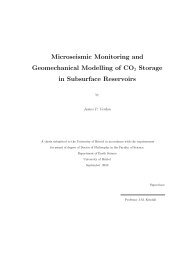MSAT - University of Bristol
MSAT - University of Bristol
MSAT - University of Bristol
Create successful ePaper yourself
Turn your PDF publications into a flip-book with our unique Google optimized e-Paper software.
the mantle a possible mechanism for the generation <strong>of</strong> seismic anisotropy is<br />
the tendency for the crystal lattices <strong>of</strong> a material undergoing plastic deformation<br />
to align. This leads to the formation <strong>of</strong> a lattice (or crystallographic)<br />
preferred orientation. The seismic anisotropy as a function <strong>of</strong> propagation direction<br />
through a single crystal becomes interesting as this is the maximum<br />
possible anisotropy that could be generated by this process (e.g. Figure 1 c–e).<br />
Deformed rocks containing diopside <strong>of</strong>ten have the diopside crystals aligned<br />
such that the (010) plane is parallel to the shear direction. For horizontal<br />
upper mantle shear and near vertical wave propagation directions (e.g. SKS<br />
phases) it is therefore instructive to consider the shear wave splitting expected<br />
for propagation in the [010] direction in diopside. As shown in Table 5 and<br />
Figure 1 this increases from 5.5% to 19.0% over the 0–20 GPa pressure range,<br />
while the measures <strong>of</strong> overall anisotropy decrease.<br />
4.2 Polycrystal anisotropy<br />
The lowermost layer <strong>of</strong> the lower mantle exhibits unusually high seismic anisotropy<br />
(Lay and Young, 1991; Vinnik et al., 1995; Kendall and Silver, 1996; Montagner<br />
and Kennett, 1996). Among the explanations for this observation is the<br />
development <strong>of</strong> a lattice preferred orientation in (Mg,Fe)SiO 3 post-perovskite.<br />
If this hypothesis is correct, it <strong>of</strong>fers the possibility <strong>of</strong> accessing lower-mantle<br />
dynamics from the observation <strong>of</strong> seismic anisotropy (e.g. Panning and Romanowicz,<br />
2004; Merkel et al., 2007). In an attempt to test this idea, Walker<br />
et al. (2011) simulated the development <strong>of</strong> post-perovskite LPO in the lowermost<br />
mantle by combining a tomography-based models <strong>of</strong> whole mantle<br />
convection (Forte, 2007; Simmons et al., 2007, 2009) with models <strong>of</strong> polycrys-<br />
17











